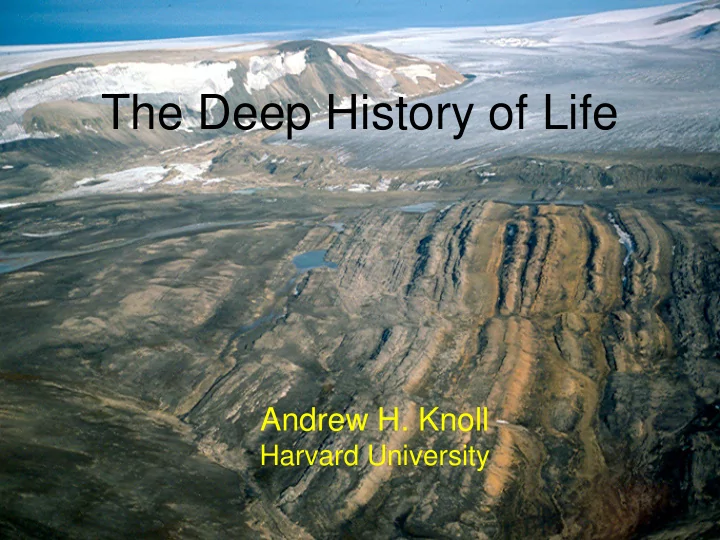

The Deep History of Life Andrew H. Knoll Harvard University
James Hutton (1788): Earth is a dynamic Planet
Charles Darwin (1859): Populations are also dynamic.
Percival Lowell (1908): Planetary change is directional .
Earth preserves a record of its biological and environmental history.
Comparative biology and evolutionary history Teilhardina magnoliana
Haikouichthys, ca. 520 Ma 542 Yunnanozoan, ca. 520 Ma
Earliest evidence of animals
End of the trail for animals What happened back here?
Comparative biology suggests a potentially long pre-animal history of life.
Can a microbial history be captured by the fossil record?
• Carbonates, similar to those deposited today on Bahama Banks • Lamination, comparable to laminae formed today by microbial mats • Tepee structures indicate exposed tidal flat • Early diagenetic chert nodules preserve microfossils (below, each spheroid is ca. 4 microns)
Microfossil Interpretation • Diagnostic Form • Life Cycle • Behavior (Orientation) • Environmental Setting • Taphonomy • Distinctive stalk- forming fossils preserved in tidal flat cherts • Some form mono- specific crusts
Ancient-Modern Comparison Modern Bahama Banks: close environmental analog Find stalk-forming cyanobacteria that build crusts Very close morphological, life cycle and environmental comparison across 750-800 million years
Microfossils record a broad diversity of life in the late Proterozoic ocean
Stromatolites
Modern stromatolites guide interpretation of ancient Shark Bay, Australia; Cross- section courtesy of J.W. Schopf
Biomarker Molecular Fossils • Preserved molecules of known biosynthetic origin • DNA and proteins rarely preserved, and not known from Precambrian rocks • Lipids preserve well
Biological Influence on the Isotopic Composition of Seawater • Autotrophic organisms take up CO 2 containing 12 C in preference to 13 CO 2 – a kinetic isotope effect • Fractionation, the difference between the isotopic composition of C in carbonate and C in co- occurring organic matter, preserves a record of biology • Sulfur isotopes preserve a similar biogeochemical record
• Modern microbial ecosystems provide keys to the physical and biological interpretation of sedimentary rocks deposited before the evolution of animals. • In 750-800 million year old rocks of Spitsbergen, the fingerprints of biology are everywhere • What do we see in older rocks?
Bil’yakh Group, northern Siberia (~1500 Ma)
Widespread Evidence of Life C and S isotopic signatures, molecular biomarkers
North Pole, Australia: The Warrawoona Group (3.45 Ga)
Stromatolites (plus C and S isotopes)
• Available evidence suggests that life originated early in Earth history • BUT, at present few hard facts about the nature of early life • EXCEPT, that it worked without oxygen
Several lines of evidence indicate oxygenation 2.4 Ga • Banded iron formation • Detrital uraninite, siderite, and pyrite • Paleosols • Sulfur isotopes Our hero
How much O 2 accumulated? Lyons et al. (2014)
* * * * * * * * * * * * * * * Known from mid-Proterozoic rocks (Tomitani et al., 2006) Life at Middle Age: Abundant and diverse cyanobacteria
50 µ m Early Eukaryotes Satka favosa Tappania plana 50 µ m Valeria lophostriata Grypania spiralis
Building Diversity
Animals: 800 Ma origin but diversification after 600 Ma Erwin et al. (2011)
When did atmosphere/ocean begin its transition to a more modern state? Partin et al. (2013)
Carnivory links oxygen and ecology Sperling et al. (2013)
Surface OMZ High O 2 O 2 Animals Fe Fe Low O 2 (HS - ) Eukaryotes Aerobic Metabolism Fe No O 2 Anaerobic Bacteria and Archaea
Evolution plays out on a dynamic planet
The Evolutionary Present Jim Barry (MBARI)
Recommend
More recommend